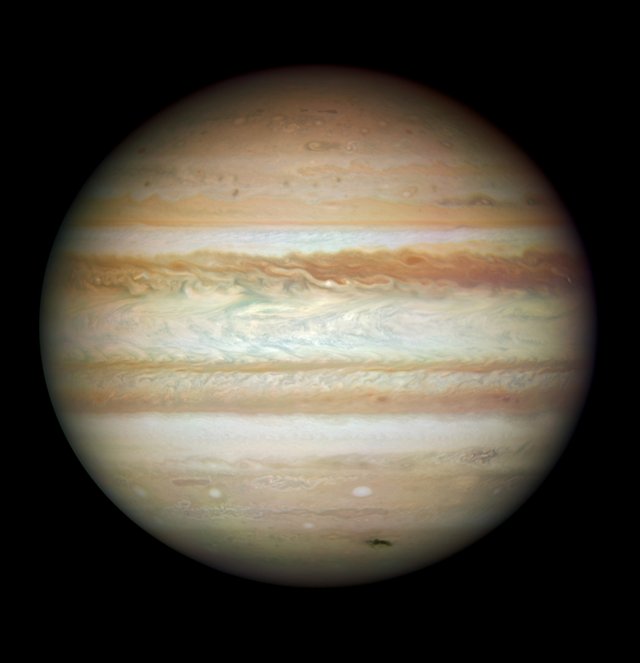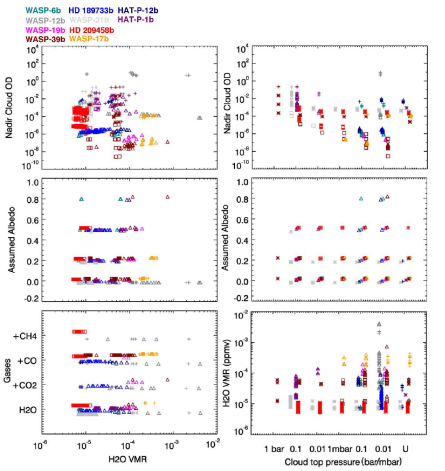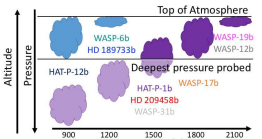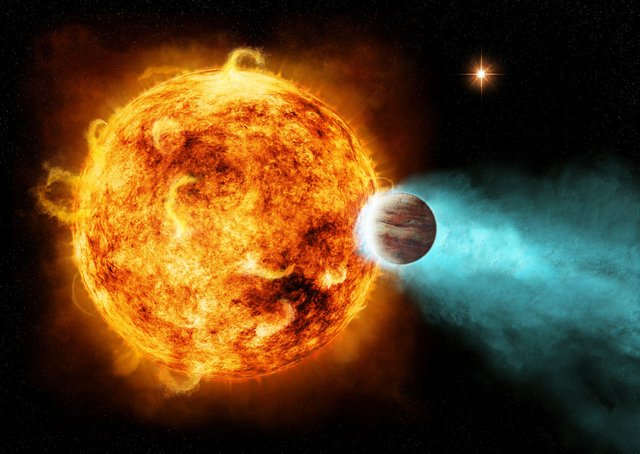The Hot Jupiters of Other Worlds -Part Two- Atmospheric Features and Albedo
What is the Atmosphere Like?
In my last post we learned the composition and the names, but that doesn't tell the whole story!

(source)
Atmospheres Have Many Different Variables
Each one is different from another in some way. We have composition, weather patterns, size, pressure and the amount of heat it gets from its star. All of these has a major effect on the atmosphere.
The Atmospheres in Depth

(source)
The above picture describes the atmospheric models applied. HD 209458b,
WASP-31b and WASP-39b are planets that most fit "grey models" (squares or asterisks). The grey model assumes that all radiation is absorbed at the same rate for all frequencies. Most are Rayleigh scattering (crosses and triangles), which is another approximation. Rayleigh scattering assumes that light scatters from the atmosphere and is not absorbed much. HAT-P-1b is the only that fits both models well. Another model, which describes a "clear" atmosphere has a few solutions for each but only WASP-39b fits it well. (This one is the diamonds.)
Cloud behavior
HD 189733b , HAT-P-12b, WASP-6b, WASP-12b, WASP-17b and WASP-19b have a top cloud pressure of 1 mbar or lower (A bar is about 0.986 an atmospheric pressure here on Earth, while a mbar aka millibar is one one thousandth of a bar.) This means that the clouds are most likely high up in the atmosphere. HATP-1b has the lowest clouds with their top pressure most likely being 0.01 to 0.1 bar. HD 209458 has high clouds at less than one mbar up to about 0.01 bar. This range is so big because it is difficult to analyze. For WASP 39b the clouds reside in the thicker part of the atmosphere for this planet with estimates from 0.01 bar to 1 bar. Determining more information about clouds is no easy feat. With only the possible combination of atmospheric makeup and amount of light that reflects off it we can estimate the optical depth (Optical depth is how far you can see through the atmosphere, basically transparency), which helps us in understanding the clouds.

(source)
HD 209458 is average for the optical depth of the planets. Cloud height, thickness and composition all factor into this. WASP-31b is similar to HD 209458 in the range of cloud pressures and possible optical depth. WASP-39b has a more normal relationship between cloud pressure and optical depth, and in most simulations at high pressure it had a high optical depth with high pressure and vice versa. HD 189733b fits best with the models with a high Rayleigh scattering high in the atmosphere. This most likely is due either to aerosols which condense high up in the atmosphere because it is cooler or because of a "photochemically produced haze" deeper in the atmosphere. We actually don't know any the latter that could form and be stable in that planet's atmosphere. These phenomena reduces HD 18733b's optical depth by a large amount.
We also observe a pattern among some of the planets and their heat. WASP-6b, HAT-P-12b and HD 189733b are all most likely less than 1300 Kelvin (K) (about 1000 °C or 1900 °F) while WASP-12b, WASP-17b, WASP-19b are all most likely over 1700 K (1400 °C or 2600 °F). HD 209458b and WASP-31b are the only two between this region. Even though they vary a lot, scientists still call all of them Hot Jupiters for a reason! WASP-6b, HAT-P-12b, HD 189733b, WASP-12b, WASP-17b, WASP-19b, the three hottest and coldest, all fit Rayleigh scattering the best. The two more "average" planets support the grey clouds model better. This may be because at about 1000 K a form of MnS, Na2S and KCl are likely to condense, and these liquids are known to scatter light.

(source)
The clouds on the colder planets may exhibit a behavior theorized on brown dwarfs. The clouds may form high up and condense, eventually falling back towards the ground with new clouds forming above it. This may be one reason why it is hard to read their atmospheres. This theory is supported by albedo, or how much light is reflected from an astronomical object. (The higher albedo the more it reflects) Albedo and total energy from the host star are used as a proxy for the temperature of any far away objects, as we can not measure their temperatures directly. Even though we use it to measure temperature, albedo itself is hard to measure, because it only has a small effect on the light spectrum. This means it is hard to get an exact estimate and a relatively large range of possibilities are usually found, with the aid of simulations. If an object has a measurable albedo it has a different day and night temperature, as well as different temperature at the poles, which is the main cause of wind. HAT-P-12b and WASP-6b most likely have the highest albedo, their range extends past 0.8 while the other planets ranges' do not extend that high. The ones with the lowest albedo are WASP-12b, WASP-31b, WASP-17b and WASP-39b all with albedos less than 0.5. By comparison, the Earth has an albedo of 0.3, as it absorbs a very large amount when compared to these Hot Jupiters. When we use albedo, we can find out about cloud cover, not just how much is reflected back at us. WASP-6b, HD 189733b, HAT-P-12b and WASP-12b have the most cloud cover, and are all fit the Rayleigh scatter models with high clouds. The less cloudy planets (except WASP-19b and WASP-17b) fit grey cloud models better with a more flat spectrum. This is logical as the slope of the spectrum is one of the ways we find the cloudiness of a planet. WASP-31b is the only planet with a cloud model that supports two different cloud makeups. This is hinted to as the spectrum is flatter at longer wavelengths and Rayleigh scattering at shorter. They did not use models with multiple types of clouds for this analysis, however they later tried a multi-component model, but this model did not provide anything better analytics than the single component. So since the more complicated model didn't yield any more useful information they opted to use the simpler single component one.

(source)